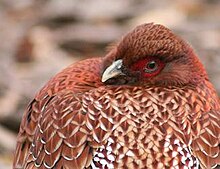The copper pheasant or Soemmerring's pheasant (Syrmaticus soemmerringii), and known locally as yamadori (山鳥), is a pheasant endemic to Japan. The scientific name commemorates the German scientist Samuel Thomas von Sömmerring.
| Copper pheasant | |
|---|---|

| |
| Scientific classification | |
| Domain: | Eukaryota |
| Kingdom: | Animalia |
| Phylum: | Chordata |
| Class: | Aves |
| Order: | Galliformes |
| Family: | Phasianidae |
| Genus: | Syrmaticus |
| Species: | S. soemmerringii
|
| Binomial name | |
| Syrmaticus soemmerringii (Temminck, 1830)
| |

Taxonomy edit
The copper pheasant was described in 1893 by Temmerick as Syrmaticus soemmerringi.[2]
Five subspecies of Copper pheasant are generally recognized, which become progressively darker further south in its distribution:
- S. soemmeringii soemmeringii, Soemmering's Copper pheasant, the nominate subspecies, of northern and central Kyushu. This form is dark reddish overall with an amber sheen to the rump and the tips of the upper-tail coverts.
- S. s. ijimae, the Ijima Copper pheasant, of southeast Kyushu. Similar to soemmeringii, but the male has a white rump.
- S. s. scintillans, the Scintillating Copper pheasant, of northern and central Honshu. The northernmost and palest subspecies, with broad white fringes on it belly and flanks.
- S. s. intermedius, the Shikoku Copper pheasant, of southwest Honshu and Shikoku. Darker than scintillans but also has white fringes on belly and flanks.
- S. s. subrufus, the Pacific Copper pheasant, of southeast Honshu and southwest Shikoku. Has golden instead of white fringes on the rump and upper-tail coverts.
Description edit
It is a large pheasant with a rich coppery chestnut plumage, yellowish bill, brown iris and red facial skin. The female is a brown bird with greyish brown upperparts and buff barred dark brown below. The male has short spurs on its grey legs, while the female has none. He measures 87.5–136 cm (34.5–54 in) long including the tail, while the female measures 51–54 cm (20–21 in) (subspecies scintillating copper pheasant, scintillans) including the tail.[3]
Distribution and habitat edit
The copper pheasant is distributed in and endemic to the hill and mountain forests of Honshū, Kyūshū and Shikoku islands of Japan, where it is known as yamadori (山鳥).[2]
Behavior and ecology edit
Breeding edit
The copper pheasant's mating season occurs between March and July, with the exact month depending local climate. During this time, males perform their wing-whirring display and sometimes call. Copper pheasants nest on the ground. Captive birds have a clutch of ten to twenty eggs, while wild birds only have a clutch of seven to thirteen eggs. Eggs take a little over three weeks to hatch, and young birds reach maturity in less than a year.[4]
Food and feeding edit
The diet consists mainly of insects, arthropods, and acorns.[5]
In culture edit
The copper pheasant appears in Japanese poetry as far back as poetry composed by Kakinomoto no Hitomaro in the early 8th century, as compiled in the Hyakunin Isshu:[6]
Ashibiki no yamadori no wo no shidari-wo no naga-nagashi yo wo hitori ka mo nemu
Must I sleep alone through the long autumn nights, long like the dragging tail of the mountain pheasant separated from his dove?
Historically, the copper pheasent has been a popular game animal in Japan, with an estimated 500,000 birds killed annually in 1975.[7]
Status edit
As of 2016, the number of wild adults is unknown. Due to continued habitat loss, non-native predation, and historic overhunting, the copper pheasant was evaluated as Near Threatened on the IUCN Red List of Threatened Species.[8].
In 1976, to prevent further decline of the species, it was made illegal to kill female copper pheasants in Japan.[7][8]
References edit
- ^ BirdLife International (2016). "Syrmaticus soemmerringii". IUCN Red List of Threatened Species. 2016: e.T22679340A92811551. doi:10.2305/IUCN.UK.2016-3.RLTS.T22679340A92811551.en. Retrieved 12 November 2021.
- ^ a b Johnsgard 199, p. 269.
- ^ Handbook of the Birds of the World, Volume 2, Lynx Edicions, Barcelona
- ^ Johnsgard 1999, p. 271.
- ^ Johnsgard 199, p. 270.
- ^ Mostow, Joshua S. (1996). Pictures of the Heart: The Hyakunin Isshu in Word and Image. University of Hawaii Press. p. 149. ISBN 0-8248-1705-2.
- ^ a b Johnsgard 199, p. 272.
- ^ a b BirdLife International 2016.
Bibliography edit
- BirdLife International. 2016. Syrmaticus soemmerringii. The IUCN Red List of Threatened Species 2016: e.T22679340A92811551. https://dx.doi.org/10.2305/IUCN.UK.2016-3.RLTS.T22679340A92811551.en. Accessed on 09 May 2024.
- Johnsgard, Paul A. (1999). The pheasants of the world: biology and natural history (2nd ed.). Washington, DC: Smithsonian Institution Press. p. 271. ISBN 978-1-56098-839-7.
